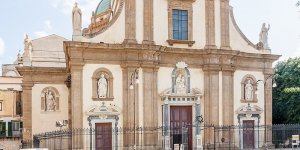| Published in Attractions / Places of Interest |
Alamo Mission in San Antonio (Misión de Álamo), Texas, United States

The Alamo in San Antonio, Texas. ![]()
Commonly called The Alamo and originally known as the Misión San Antonio de Valero, is a historic Spanish mission and fortress compound founded in the 18th century by Roman Catholic missionaries in what is now San Antonio, Texas, United States. It was the site of the Battle of the Alamo in 1836. Today it is a museum in the Alamo Plaza Historic District.
The historic district was one of the early Spanish missions in Texas, built for the education of local American Indians after their conversion to Christianity. The mission was secularized in 1793 and then abandoned. Ten years later, it became a fortress housing the Second Flying Company of San Carlos de Parras military unit, who likely gave the mission the name Alamo.
During the Texas Revolution, Mexican General Martín Perfecto de Cos surrendered the fort to the Texian Army in December 1835, following the Siege of Béxar. A relatively small number of Texian soldiers then occupied the compound for several months.
The defenders were wiped out at the Battle of the Alamo on March 6, 1836. As the Mexican Army retreated from Texas several months later, they tore down many of the Alamo walls and burned some of the buildings.

Alamo Memorial with Bonham and Bowie. ![]()
The Alamo was designated a National Historic Landmark on December 19, 1960, and was documented by the Historic American Buildings Survey in 1961. It was an inaugural listing on the National Register of Historic Places in 1966, and is a contributing property to the Alamo Plaza Historic District, which was designated in 1977.
As San Antonio prepared to host the Hemisfair in 1968, the long barracks was roofed and turned into a museum. Few structural changes have taken place since then.
According to Herbert Malloy Mason's Spanish Missions of Texas, the Alamo is one of "the finest examples of Spanish ecclesiastical building on the North American continent".
The mission, along with others located in San Antonio, is at risk from environmental factors, however. The limestone used to construct the buildings was taken from the banks of the San Antonio River. It expands when confronted with moisture and then contracts when temperatures drop, shedding small pieces of limestone with each cycle. Measures have been taken to partially combat the problem.
Visitors may tour the chapel, as well as the Long Barracks, which contains a small museum with paintings, weapons, and other artifacts from the era of the Texas Revolution.
Additional artifacts are displayed in another complex building, alongside a large diorama that recreates the compound as it existed in 1836. A large mural, known as the Wall of History, portrays the history of the Alamo complex from its mission days to modern times.
Daily 9AM-5:30PM, closed Christmas Eve and Christmas Day. Admission is free, although donations are appreciated. Revenues from an adjacent gift shop fund the historic preservation efforts. (Wikipedia)
YOU MAY ALSO LIKE





 If you own or manage a travel-related business such as a hotel, a bed-and-breakfast, a restaurant, a pub or a cafeteria, you can create a web page for your business for free on Titi Tudorancea Travel Info. » |


